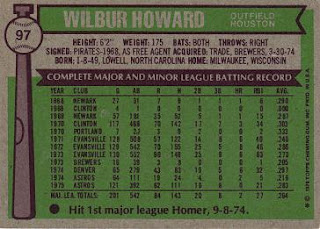

When I was a little one I sometimes got Darrell and Dwight Evans mixed up.
Darrell Evans was a solid third baseman for several years. He had a great batting eye, twice leading the NL in bases on balls. Darrell had pretty good power--he was always in double-figures in home runs and he hit over 30 homers four times. Darrell was named to two All-Star teams (1973 and 1983).
Evans started with the Braves in 1969, playing 12 games in both the '69 and '70 seasons. He split time between 3B and LF in 1971 and had his first double-figure HR season. Darrell became the regular 3B in 1972 and had his best season in 1973 when he batted .281, homered 41 times, had 104 RBI, and led the NL in walks with 124.
Evans got off to a bad start in 1976 (.173 with one home run in 139 at bats), so on June 13 he was traded with Marty Perez to the San Francisco Giants for Willie Montanez and some spare parts. The 1976 season was basically a lost season for Darrell, as he didn't do much better with the Giants. But he bounced back in 1977 by batting .254 with 17 homers. He had several similar years with the Giants through the 1983 season. His best year with the Giants was 1983 when he batted .277 with 30 home runs.
Darrell signed with Detroit as a free agent after the 1983 season and they won the World Championship in 1984. Evans didn't have one of his better years that year, but he got a ring. He had good power years in 1985 (40 HR) and 1987 (34 HR).
Here is a 1987 New York Times article about Evans. He left the Tigers as a free agent after the 1988 season and finished his career with the Braves in 1989.
Darrell has spent time in various minor league managing and coaching capacities since his retirement. He and several other former major leaguers started a
website to try to raise environmental awareness.
"No better feeling (hitting a home run) in the whole world. It is what you live for. Sometimes it is what you die for. You put one up there and it makes you feel young again." - Darrell Evans in Baseball Digest (July 1986)



















































































































































